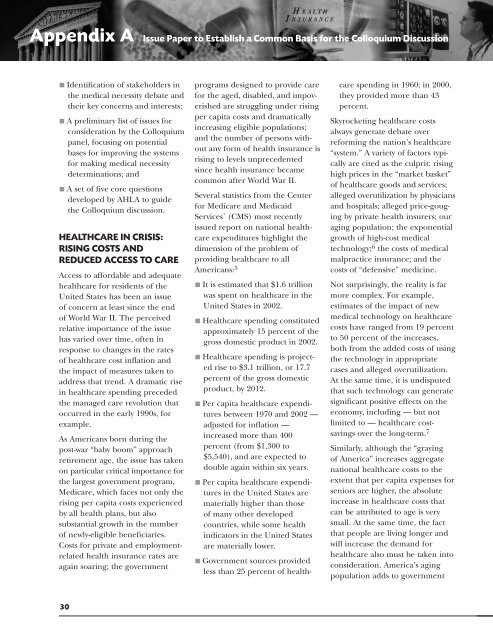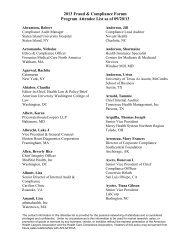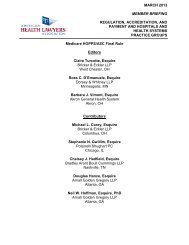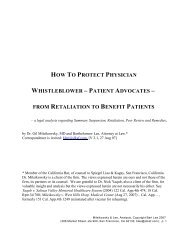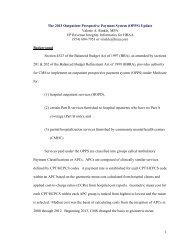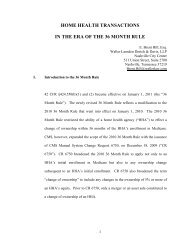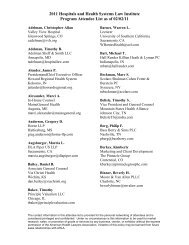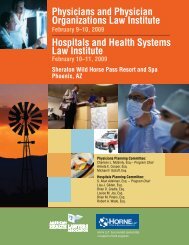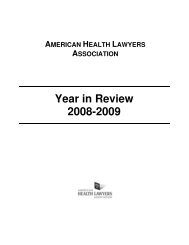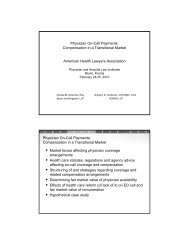Medical Necessity - American Health Lawyers Association
Medical Necessity - American Health Lawyers Association
Medical Necessity - American Health Lawyers Association
You also want an ePaper? Increase the reach of your titles
YUMPU automatically turns print PDFs into web optimized ePapers that Google loves.
Appendix A Issue Paper to Establish a Common Basis for the Colloquium Discussion<br />
■ Identification of stakeholders in<br />
the medical necessity debate and<br />
their key concerns and interests;<br />
■ A preliminary list of issues for<br />
consideration by the Colloquium<br />
panel, focusing on potential<br />
bases for improving the systems<br />
for making medical necessity<br />
determinations; and<br />
■ A set of five core questions<br />
developed by AHLA to guide<br />
the Colloquium discussion.<br />
HEALTHCARE IN CRISIS:<br />
RISING COSTS AND<br />
REDUCED ACCESS TO CARE<br />
Access to affordable and adequate<br />
healthcare for residents of the<br />
United States has been an issue<br />
of concern at least since the end<br />
of World War II. The perceived<br />
relative importance of the issue<br />
has varied over time, often in<br />
response to changes in the rates<br />
of healthcare cost inflation and<br />
the impact of measures taken to<br />
address that trend. A dramatic rise<br />
in healthcare spending preceded<br />
the managed care revolution that<br />
occurred in the early 1990s, for<br />
example.<br />
As <strong>American</strong>s born during the<br />
post-war “baby boom” approach<br />
retirement age, the issue has taken<br />
on particular critical importance for<br />
the largest government program,<br />
Medicare, which faces not only the<br />
rising per capita costs experienced<br />
by all health plans, but also<br />
substantial growth in the number<br />
of newly-eligible beneficiaries.<br />
Costs for private and employmentrelated<br />
health insurance rates are<br />
again soaring; the government<br />
programs designed to provide care<br />
for the aged, disabled, and impoverished<br />
are struggling under rising<br />
per capita costs and dramatically<br />
increasing eligible populations;<br />
and the number of persons without<br />
any form of health insurance is<br />
rising to levels unprecedented<br />
since health insurance became<br />
common after World War II.<br />
Several statistics from the Center<br />
for Medicare and Medicaid<br />
Services’ (CMS) most recently<br />
issued report on national healthcare<br />
expenditures highlight the<br />
dimension of the problem of<br />
providing healthcare to all<br />
<strong>American</strong>s: 5<br />
■ It is estimated that $1.6 trillion<br />
was spent on healthcare in the<br />
United States in 2002.<br />
■ <strong>Health</strong>care spending constituted<br />
approximately 15 percent of the<br />
gross domestic product in 2002.<br />
■ <strong>Health</strong>care spending is projected<br />
rise to $3.1 trillion, or 17.7<br />
percent of the gross domestic<br />
product, by 2012.<br />
■ Per capita healthcare expenditures<br />
between 1970 and 2002 —<br />
adjusted for inflation —<br />
increased more than 400<br />
percent (from $1,300 to<br />
$5,540), and are expected to<br />
double again within six years.<br />
■ Per capita healthcare expenditures<br />
in the United States are<br />
materially higher than those<br />
of many other developed<br />
countries, while some health<br />
indicators in the United States<br />
are materially lower.<br />
■ Government sources provided<br />
less than 25 percent of healthcare<br />
spending in 1960; in 2000,<br />
they provided more than 43<br />
percent.<br />
Skyrocketing healthcare costs<br />
always generate debate over<br />
reforming the nation’s healthcare<br />
“system.” A variety of factors typically<br />
are cited as the culprit: rising<br />
high prices in the “market basket”<br />
of healthcare goods and services;<br />
alleged overutilization by physicians<br />
and hospitals; alleged price-gouging<br />
by private health insurers; our<br />
aging population; the exponential<br />
growth of high-cost medical<br />
technology; 6 the costs of medical<br />
malpractice insurance; and the<br />
costs of “defensive” medicine.<br />
Not surprisingly, the reality is far<br />
more complex. For example,<br />
estimates of the impact of new<br />
medical technology on healthcare<br />
costs have ranged from 19 percent<br />
to 50 percent of the increases,<br />
both from the added costs of using<br />
the technology in appropriate<br />
cases and alleged overutilization.<br />
At the same time, it is undisputed<br />
that such technology can generate<br />
significant positive effects on the<br />
economy, including — but not<br />
limited to — healthcare costsavings<br />
over the long-term. 7<br />
Similarly, although the “graying<br />
of America” increases aggregate<br />
national healthcare costs to the<br />
extent that per capita expenses for<br />
seniors are higher, the absolute<br />
increase in healthcare costs that<br />
can be attributed to age is very<br />
small. At the same time, the fact<br />
that people are living longer and<br />
will increase the demand for<br />
healthcare also must be taken into<br />
consideration. America’s aging<br />
population adds to government<br />
30


